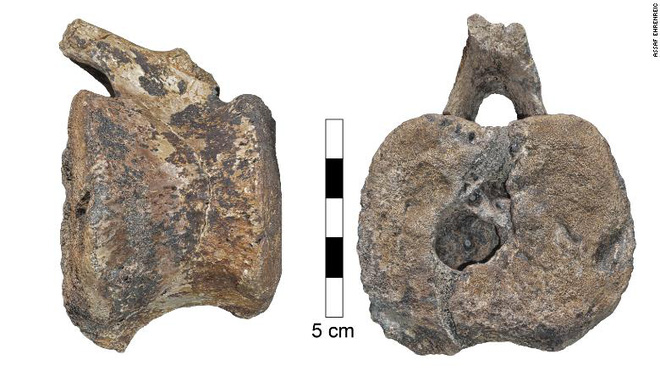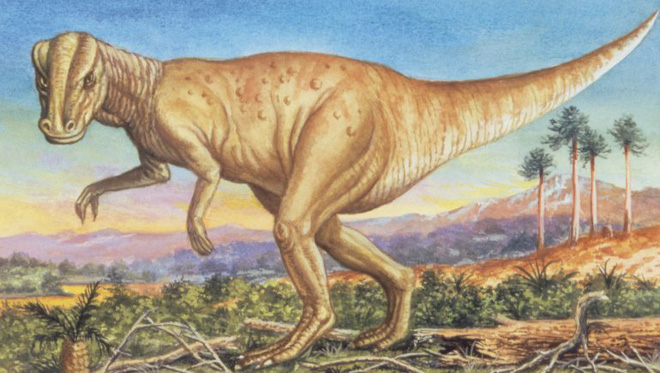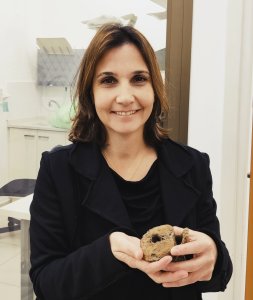66 million-year-old dinosaur fossils contain a rare disease in modern-day children
A rare human disease has just been found inside the fossil of a platypus. The dinosaur once lived on Earth 66 million years ago and the fossil of an individual was discovered in Dinosaur Provincial Park in southern Alberta, Canada.
Scientists at Tel Aviv University have discovered unusual gaps in the two tails of the platypus. They compared the vertebrae of the dinosaur to the bones of two benign tumors caused by the tissue-cell syndrome (Langerhans cell histiocytosis). This is a rare disease that can sometimes be very painful and affects primarily children, especially boys.

Burning the vertebrae of a speculum dinosaur
"Diagnosis of disease based on remnant bones and fossils is complicated because many types of diseases leave the same marks on bones. However, for histologic syndrome, it leaves a very characteristic and completely edematous trace. matches the lesions found in fossils, " said Dr. Hila May. She heads the Division of Evolutionary Medicine and Biological History at the Sackler School of Medicine at Tel Aviv University.
Scientists use high-resolution CT scanning method to study the fossil tail of the dinosaur.
"New types of technology, such as micro CT scans, have given us the ability to examine the structure of lesions and recreate the spread along the blood vessels that feed the disease , " May said. "Micro and macro analyzes confirm that the disease is a histologic syndrome. This is the first time we've discovered it in dinosaurs."

Speculum dinosaur
In humans, the disease is sometimes described as a rare cancer. But according to May, experts have mixed opinions, they are not sure if it is cancer or not, because in some cases, it naturally disappears.
"The majority of tumors caused by the tissue syndrome appear in the bones of children aged 2 to 10 years old. They can cause a lot of pain. But fortunately, in most cases, these tumors themselves." disappears without any intervention " . May said.
The scientific report on this research was published this week in Scientific Reports. According to the report, they were about 10 meters tall, weighed several tons and lived in groups of 66 to 80 million years ago.
The disease of dinosaurs
Like humans, dinosaurs also get sick. But evidence of diseases and infections found in fossils is scarce.
However, there is ample evidence to prove that tyrannosaurs, such as T-Rex, have suffered from gout and that iguanodons may have had osteoarthritis. Cancer is much harder to guess but now there is evidence that the dinosaurs have acquired them. The above information is given in the report.
May explained that studying the diseases present in many species in fossils is a complex task. For extinct animals, since we don't have a living individual to refer to, this task will become even more complex.

Dr. Hila May holds a vertebrae fossilized by a platypus
The authors say that the findings could support evolutionary medicine - a new field of research focused on understanding the development and behavior of diseases over time.
Because many of the diseases humans have come from come from animals (coronavirus, HIV and tuberculosis), May said that understanding of the ability to spread through different species and the evolution of fertility the survival of ailments can assist in the search for new and effective treatments.
"When we know that a disease does not only appear in one species or in a certain time period, it means that the biological mechanism that triggers the development of the disease is not unique to the behavior or environment of the individual. human, instead [it] is a basic physiological problem of the organism , " May said.
According to CNN
You should read it
- Jurassic dinosaur eggs from Jurassic era were discovered in China
- The 110 million-year-old dinosaur fossil intact as alive
- What flavor does the dinosaur meat taste good or not?
- What is the ending of the dinosaur game T-Rex on Chrome?
- The stone wall imprinted over 5000 giant dinosaur footprints in Bolivia
- How to play games on Chrome when losing life and have Internet
- The 66-million-year-old rare dinosaur fossil was found in Colorado
- Defeating the blue whale, this 37m-long dinosaur is the world's largest creature
May be interested
- A new breed of turkey dinosaurs found in Australia
 a part of the herbivorous dinosaur skeleton, just as small as a new turkey was discovered in the 113 million year old rock in southeastern australia, which could explain the connection between dinosaurs and birds.
a part of the herbivorous dinosaur skeleton, just as small as a new turkey was discovered in the 113 million year old rock in southeastern australia, which could explain the connection between dinosaurs and birds. - Fossils of Thailand's largest dinosaur have just been found
 a fossil of a supposedly largest dinosaur ever found in thailand was discovered in the northeastern part of this country.
a fossil of a supposedly largest dinosaur ever found in thailand was discovered in the northeastern part of this country. - The mystery of the 290-million-year-old giants challenges scientists around the world
 according to the study, this fossil footprint dates back to the permian period (from 248 to 290 million years ago), far away from the time when humans and birds appeared on earth.
according to the study, this fossil footprint dates back to the permian period (from 248 to 290 million years ago), far away from the time when humans and birds appeared on earth. - 200 million year old dinosaur footprints are found in Africa
 a group of scientists discovered the footprint of a giant carnivorous dinosaur in southern africa nearly 200 million years ago.
a group of scientists discovered the footprint of a giant carnivorous dinosaur in southern africa nearly 200 million years ago. - The most bizarre things people ever bring to space
 in the process of conquering the universe, people brought a lot of daily equipment and supplies into space for different purposes, among them a few strange objects such as toys, pizzas, dinosaur fossils ... made many people not surprised.
in the process of conquering the universe, people brought a lot of daily equipment and supplies into space for different purposes, among them a few strange objects such as toys, pizzas, dinosaur fossils ... made many people not surprised. - The first photosynthesis happened about 1.25 billion years ago
 identifying and analyzing fossils of algae, thought to be the oldest ancestor of modern plants and animals, scientists have revealed that photosynthesis in plants took place 1.25 billion ago. last year.
identifying and analyzing fossils of algae, thought to be the oldest ancestor of modern plants and animals, scientists have revealed that photosynthesis in plants took place 1.25 billion ago. last year. - A 125 million year old herbivorous dinosaur has been discovered
 many bones suspected of being a dinosaur called the moabosaurus utahensis have been found to receive the interest of international archaeologists.
many bones suspected of being a dinosaur called the moabosaurus utahensis have been found to receive the interest of international archaeologists. - Intelligent robot implants to treat rare birth defects in the esophagus
 stenosis of the esophagus is a rare inherited disease, in which the upper and lower part of the baby's esophagus is atrophied, with no two-headed association.
stenosis of the esophagus is a rare inherited disease, in which the upper and lower part of the baby's esophagus is atrophied, with no two-headed association. - Defeating the blue whale, this 37m-long dinosaur is the world's largest creature
 the fossil of this dinosaur has an incredible size: 37m long, weighs 69-76 tons, the femur is longer than an adult. they are the largest creatures ever walking on land in history.
the fossil of this dinosaur has an incredible size: 37m long, weighs 69-76 tons, the femur is longer than an adult. they are the largest creatures ever walking on land in history. - Children with anorexia must how to help their babies eat well?
 anorexia is a constant worry of many parents. especially for children aged 1-4 years old, anorexia situation occurs more commonly. understanding that worry, today will help you to answer the question: what should children do?
anorexia is a constant worry of many parents. especially for children aged 1-4 years old, anorexia situation occurs more commonly. understanding that worry, today will help you to answer the question: what should children do?










 A galaxy 500 million light-years away that emits radio waves with a 16-day cycle 'almost like squeezing lemons'
A galaxy 500 million light-years away that emits radio waves with a 16-day cycle 'almost like squeezing lemons' About 6 billion years from now, the light from the dying Sun will burn the asteroid belt
About 6 billion years from now, the light from the dying Sun will burn the asteroid belt Bill Gates: Artificial intelligence and gene editing technology will save humanity
Bill Gates: Artificial intelligence and gene editing technology will save humanity Breakthrough: The first discovery of an oxygen molecule outside the Milky Way
Breakthrough: The first discovery of an oxygen molecule outside the Milky Way In the future, scientists will use crystals to encode information
In the future, scientists will use crystals to encode information Discovered 'hidden bomb' in the soil: industrial chemicals have the ability to affect the immune system and fertility in humans
Discovered 'hidden bomb' in the soil: industrial chemicals have the ability to affect the immune system and fertility in humans